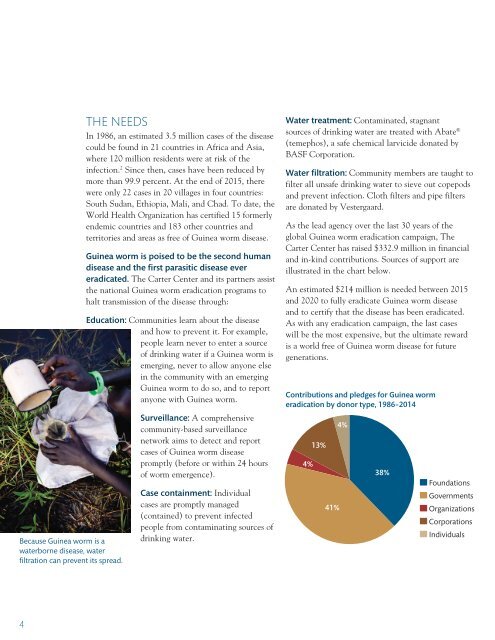ERADICATION OF GUINEA WORM DISEASE
1o72uNl
1o72uNl
You also want an ePaper? Increase the reach of your titles
YUMPU automatically turns print PDFs into web optimized ePapers that Google loves.
Because Guinea worm is a<br />
waterborne disease, water<br />
filtration can prevent its spread.<br />
THE NEEDS<br />
In 1986, an estimated 3.5 million cases of the disease<br />
could be found in 21 countries in Africa and Asia,<br />
where 120 million residents were at risk of the<br />
infection. 2 Since then, cases have been reduced by<br />
more than 99.9 percent. At the end of 2015, there<br />
were only 22 cases in 20 villages in four countries:<br />
South Sudan, Ethiopia, Mali, and Chad. To date, the<br />
World Health Organization has certified 15 formerly<br />
endemic countries and 183 other countries and<br />
territories and areas as free of Guinea worm disease.<br />
Guinea worm is poised to be the second human<br />
disease and the first parasitic disease ever<br />
eradicated. The Carter Center and its partners assist<br />
the national Guinea worm eradication programs to<br />
halt transmission of the disease through:<br />
Education: Communities learn about the disease<br />
and how to prevent it. For example,<br />
people learn never to enter a source<br />
of drinking water if a Guinea worm is<br />
emerging, never to allow anyone else<br />
in the community with an emerging<br />
Guinea worm to do so, and to report<br />
anyone with Guinea worm.<br />
Surveillance: A comprehensive<br />
community-based surveillance<br />
network aims to detect and report<br />
cases of Guinea worm disease<br />
promptly (before or within 24 hours<br />
of worm emergence).<br />
Case containment: Individual<br />
cases are promptly managed<br />
(contained) to prevent infected<br />
people from contaminating sources of<br />
drinking water.<br />
Water treatment: Contaminated, stagnant<br />
sources of drinking water are treated with Abate ®<br />
(temephos), a safe chemical larvicide donated by<br />
BASF Corporation.<br />
Water filtration: Community members are taught to<br />
filter all unsafe drinking water to sieve out copepods<br />
and prevent infection. Cloth filters and pipe filters<br />
are donated by Vestergaard.<br />
As the lead agency over the last 30 years of the<br />
global Guinea worm eradication campaign, The<br />
Carter Center has raised $332.9 million in financial<br />
and in-kind contributions. Sources of support are<br />
illustrated in the chart below.<br />
An estimated $214 million is needed between 2015<br />
and 2020 to fully eradicate Guinea worm disease<br />
and to certify that the disease has been eradicated.<br />
As with any eradication campaign, the last cases<br />
will be the most expensive, but the ultimate reward<br />
is a world free of Guinea worm disease for future<br />
generations.<br />
Contributions and pledges for Guinea worm<br />
eradication by donor type, 1986–2014<br />
4%<br />
13%<br />
41%<br />
4%<br />
FPO<br />
38%<br />
Foundations<br />
Governments<br />
Organizations<br />
Corporations<br />
Individuals<br />
4


